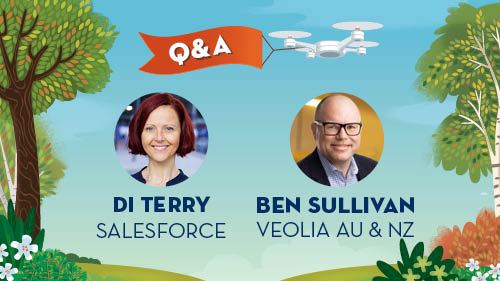Q&A: How Veolia’s Collaborative IT Drives Digital-First Businesses



A change of structure at Veolia provided the foundation for the business to tackle the demands of COVID-19. Di Terry, Salesforce’s Vice President, Australia – Solution Engineering caught up with Ben Sullivan, Chief Digital Officer, Veolia Australia & New Zealand to discuss the non-traditional structure, launching a customer hub, and becoming a data company.
Di Terry: At Veolia, how did you redefine the way technology is managed in the business?
Ben Sullivan: We made changes to put digital at the forefront of what we do. Globally, the digital side of the business had been building and we needed to reflect that locally. We created a five-year digital transformation plan to support our strategic plan called Impact 2023, and began to reshape how we operated based on four pillars: digital employees, digital customers, digital operations and digital offers.
My role – Chief Digital Officer – is a new role in the business, and we recruited a Chief Data Officer who reports into me, as do marketing and communications.
We had a CIO reporting to me, but it became apparent that we needed to be more agile. We needed to flatten the structure slightly, so the role of CIO was taken out, and the Head of Applications, Head of Infrastructure & Cyber Security, and the Service Desk all became part of my leadership team.
Ultimately, we wanted everyone to work more closely with the data team, because strategically, we want to become a data-driven company.
Di: That seems like a lot of business areas to have as essentially one team – why did you think it was important to do that?
Ben: It’s probably not always seen logically as one team, but as a leadership team, it is united. We meet regularly, and we’re seeing everyone’s goals becoming more intertwined in the delivery.
For example, we’ve recently put in a new HR and payroll system. Of course the communication requirements in the change management process were just as important as the security and data management.
In that instance, it was a lot easier in my role to have the corporate communications team with me.
Di: And how does it work for them?
Ben: Well, they might get a bit bored when we’re deep-diving into cybersecurity and talking red hats and blue hats! But ultimately having all of the teams together helps everyone understand the components of the project, and appreciate what each contributes to the overall project outcome.
Di: You had this structure in place before COVID-19. How did it work during the crisis?
Ben: I’m sure many people in business have said similar over recent months, but I’m proud of what all of the different teams have done in response to the pandemic, from an internal and external perspective.
Internally, we asked people to do what they could to reduce the overtime they were working and take leave that was due – we asked people to ‘take what you can afford’ and led this example from the top, and the team did.
We then had to work with our customers, to support them and their needs – many didn’t need our services while their businesses were shut down, and needed to cancel or postpone. We couldn’t have all of those calls come through to a call centre in a short period – like so many call centres were in that early stage of the shutdown, it would have been flooded.
Luckily, we’d developed a customer hub with Salesforce six months before, and it was still very much a version 1.0, a minimum viable product. We spun up an agile team in eight weeks to create a customer hub 2.0 – this was with everyone working remotely during May and June.
I actually think if we were in the office, we wouldn’t have been able to achieve it in that same timeframe – we wouldn’t have had that burning platform. When we were in the situation, we had a real desire and drive to get the solution out, get it complete, help our colleagues in the call centre by reducing call volume – and help our customers, too. Everyone was involved, and everyone knew the outcome we needed to achieve and the impact it would have.
Di: I think it’s fair to say that pre-COVID-19, Veolia was a rather traditional employer in terms of communications. How did you change your staff engagement?
Ben: Our Achilles’ heel has always been effective communication flow to all levels of the organisation – it has traditionally been straight down from the management and distributed via email. That can be hit and miss – whether it’s via toolbox talks or posters on the wall, some managers are better at communicating than others.
We needed a new method of communicating, so we asked for mobile numbers. There’s always been a line between work and private that people have been unwilling to cross, but this time 95 per cent of our people did share their mobile details.
We began sending short videos from the CEO with updates, and tips on keeping safe and mental health. Then we started sending pulse surveys, and we’ve been able to get some great instant feedback. This has significantly improved our communication, and our engagement figures for the first time were in the 80 to 90 per cent bracket. Traditionally, we score around the 50 per cent mark.
It has helped build trust and improve the digital skills of our employees too.
Di: Looking forward, how do you see the business and structure developing?
Ben: I think everyone’s got a greater understanding of digital and the value of that role of IT in an organisation – it’s proven critical in terms of contingency planning and survival. And that’s exciting for people leading the IT function and working in it, too – because, wherever you are on your digital journey, you’re going to have a new journey.
The important thing is that you make sure whatever you allocate time and resources to is a priority. There are going to be a lot of good ideas thrown around, and it can be easy to get distracted. But if something is not a clear priority and relevant to what the business needs to achieve, don’t do it.
To find out more, download the APAC Employee Engagement Report. You’ll also deep dive into the relationship between technology and employee engagement, and what office workers want from IT leaders now.























